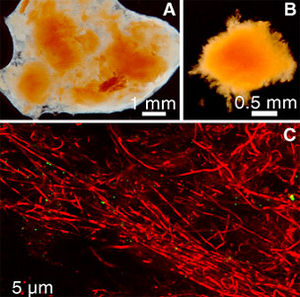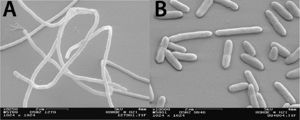Meiothermus: Difference between revisions
| Line 70: | Line 70: | ||
[2] [http://www.ncbi.nlm.nih.gov/pubmed?term=PMID%3A%2018379832 Raulio, M., Järn, M., Ahola, J., Peltonen, J., Rosenholm, J.B., Tervakangas, S., Kolehmainen, J., Ruokolainen, T., Narko, P., and Salkinoja-Salonen, M. "Microbe repelling coated stainless steel analysed by field emission scanning electron microscopy and physicochemical methods".<i> Journal of Industrial Microbiology & Biotechnology</i>. 2008. Volume 35. Number 7. p. 751-760] | [2] [http://www.ncbi.nlm.nih.gov/pubmed?term=PMID%3A%2018379832 Raulio, M., Järn, M., Ahola, J., Peltonen, J., Rosenholm, J.B., Tervakangas, S., Kolehmainen, J., Ruokolainen, T., Narko, P., and Salkinoja-Salonen, M. "Microbe repelling coated stainless steel analysed by field emission scanning electron microscopy and physicochemical methods".<i> Journal of Industrial Microbiology & Biotechnology</i>. 2008. Volume 35. Number 7. p. 751-760] | ||
[3] [http://www.ncbi.nlm.nih.gov/pubmed?term=PMID%3A%2017131103 Ekman, J., Kosonen, M., Jokela, S., Kolari, M., Korhonen, P., and Salkinoja-Salonen, M. "Detection and quantitation of colored deposit-forming Meiothermus spp. in paper industry processes and end products". <i>Journal of Industrial Microbiology & Biotechnology</i>. 2007. Volume 34. Number 3. p. 203-211] | [3] [http://www.ncbi.nlm.nih.gov/pubmed?term=PMID%3A%2017131103 Ekman, J., Kosonen, M., Jokela, S., Kolari, M., Korhonen, P., and Salkinoja-Salonen, M. "Detection and quantitation of colored deposit-forming <i>Meiothermus</i> spp. in paper industry processes and end products". <i>Journal of Industrial Microbiology & Biotechnology</i>. 2007. Volume 34. Number 3. p. 203-211] | ||
[4] [http://www.ncbi.nlm.nih.gov/pubmed?term=PMID%3A%2012700951 Kolari, M., Nuutinen, J., Rainey, F.A., and Salkinoja-Salonen, M.S. "Colored moderately thermophilic bacteria in paper-machine biofilms". <i>Journal of Industrial Microbiology & Biotechnology</i>. 2003. Volume 30. Number 4. p. 225-238] | [4] [http://www.ncbi.nlm.nih.gov/pubmed?term=PMID%3A%2012700951 Kolari, M., Nuutinen, J., Rainey, F.A., and Salkinoja-Salonen, M.S. "Colored moderately thermophilic bacteria in paper-machine biofilms". <i>Journal of Industrial Microbiology & Biotechnology</i>. 2003. Volume 30. Number 4. p. 225-238] | ||
Revision as of 23:50, 17 April 2011

Classification
Domain: Bacteria, Phylum: Deinococcus-Thermus, Class: Deinococci, Order: Thermales, Family: Thermaceae
Species
|
NCBI: Taxonomy |
- Meiothermus chiliarophilus
- Meiothermus cerbereus
- Meiothermus granaticius
- Meiothermus rosaceus
- Meiothermus ruber
- Meiothermus rufus
- Meiothermus silvanus
- Meiothermus taiwanensis
- Meiothermus timidus
Description and Significance

Before the recognition of the genus Meiothermus, the species under the genus Thermus were designated as either high or low-temperature species. The proposal of a new genus Meiothermus in 1996 was made to designate the phylogenetic, phenotypic, and chemotaxonomic distinctiveness of the species that have low optimum growth temperatures. Meiothermus indicates an organism living in a "less-hot" place [1]. The cells are 0.5 to 0.8 μm in diameter and cell length is variable - often forming short filaments. The colonies that form vary from red to yellow pigment and are often found in hydrothermal vents.
Meiothermus species have the ability to form biofilms and stick to any surface by using specific adhesion organelles [2]. Specifically, M. silvanus and M. ruber have been found to form colored biofilms on machine surfaces and spots in produced paper and board [3] - left unchecked, these biofoulers pose an economic threat to the paper industry [4]. Several techniques have been proposed to minimize biofilm growth on stainless steel and other materials used in the paper industry. One such technique used is the of coating machine surfaces with diamond-like carbon or certain fluoropolymers to prevent adhesion and biofilm growth of Meiothermus spp. [2]. Another technique used is the inactivation of microbes by electrochemical oxidation to prevent biofilm formation - this technique inactivates microbes by electrochemically generating chlorine/hypochlorite [5].
Describe the appearance, habitat, etc. of the organism, and why you think it is important.
Genome Structure
The entire genome of Meiothermus silvanus DSM 9946 has been sequenced and consist of a 3,249,394 bp long circular chromosome and two plasmids of 347,854 bp and 124,421 bp lengths, respectively. Of the 3,720 genes predicted, 3,505 were protein-coding genes and 55 were structural-RNAs [6].
Describe the size and content of the genome. How many chromosomes? Circular or linear? Other interesting features? What is known about its sequence?
Cell Structure, Metabolism and Life Cycle

Meiothermus, is a Gram-negative, aerobic microorganism that is variable in length and often forms short filaments. It is primarily an oxygenic chemoorganoheterotroph, but some species grow with nitrate as the terminal electron acceptor. As such, it utilizes such organic substrates such as starch, hexoses, pentoses, disaccharides, amino acids, and organic acids as both a carbon and energy source. The optimum growth conditions varies in a moderate temperature range (50-65°C) and alkaline environments (pH ~8.0).
Its common red-orange appearance stems from the production of carotenoids via the metabolism of tepernoids and polyketides []. The ability of thermophilic bacteria much like those from the genus Meiothermus to withstand high temperatures are thought to stem from the possession of special mechanisms for membrane stabilization. Carotenoid production may be one of the mechanisms that these bacteria possess, based on the length of carotenoid molecules and its analogue to the fatty acids of the lipid bilayer[].
Interesting features of cell structure; how it gains energy; what important molecules it produces.
Ecology and Pathogenesis
Habitat; symbiosis; biogeochemical significance; contributions to environment.
If relevant, how does this organism cause disease? Human, animal, plant hosts? Virulence factors, as well as patient symptoms.
References
[6] NCBI genome sequence for Meiothermus genus
[] Kanehisa Laboratories. "Carotenoid biosynthesis - Meiothermus ruber". 2011.
Author
Page authored by Michael Huarng and Steven Huynh, student of Prof. Jay Lennon at Michigan State University.
<-- Do not remove this line-->
